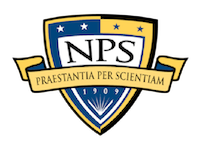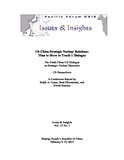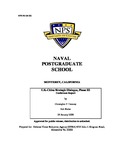US-China Strategic Nuclear Relations: Time to Move to Track-1 Dialogue
Abstract
The China Foundation for International and Strategic Studies and the Pacific Forum CSIS, with
support from the Naval Postgraduate School’s Project on Advanced Systems and Concepts for Combating
Weapons of Mass Destruction (NPS-PASCC) and the Defense Threat Reduction Agency (DTRA), held
the 9th China-US Strategic Nuclear Dynamics Dialogue on Feb. 9-10, 2015. Some 80 Chinese and US
experts, officials, military officers, and observers along with four Pacific Forum Young Leaders attended,
all in their private capacity. The off-the-record discussions covered comparative assessments of the
strategic landscape, nuclear dimensions of the “new type of major country relationship,” nonproliferation
and nuclear security cooperation, ways to address regional nuclear challenges (North Korea and Iran),
strategic stability and reassurance, and crisis management and security-building measures. A sub-group of
US participants met with VADM Sun Jianguo, Deputy Chief of the PLA General Staff. Key findings
from this meeting are outlined below.
Description
Pacific Forum CSIS, Issues & Insights Vol. 15, No. 7, US-China Strategic Nuclear Relations: Time to Move to Track-1 Dialogue, The Ninth China-US Dialogue on Strategic Nuclear Dynamics, Beijing, People’s Republic of China, February 9-10, 2015
Rights
This publication is a work of the U.S. Government as defined in Title 17, United States Code, Section 101. Copyright protection is not available for this work in the United States.Collections
Related items
Showing items related by title, author, creator and subject.
-
U.S.-China strategic dialogue, phase V, 2010
Twomey, Christopher; Glosny, Michael (Monterey, California. Naval Postgraduate School, 2010); NPS-NS-10-002The fifth annual session of the U.S.-China Strategic Dialogue was held in Honolulu, HI from May 2 through 4, 2010. The Dialogue is a track 1.5 conference; thus, it is formally unofficial, but includes a mix of government ... -
U.S.-China Strategic Dialogue, Phase V, 2010
Glosny, Michael; Twomey, Christopher (Monterey, California. Naval Postgraduate School, 2010-10-22); NPS-NS-10-002The fifth annual session of the U.S.-China Strategic Dialogue was held in Honolulu, HI from May 2 through 4, 2010. The Dialogue is a track 1.5 conference; thus, it is formally unofficial, but includes a mix of government ... -
U.S.-China Strategic dialogue, phase III: conference report
Twomey, Christopher P.; Shelor, Kali (Monterey, California. Naval Postgraduate School, 2008); NPS-NS-08-002The third annual session of the U.S.-China Strategic Dialogue was held in Honolulu, HI from November 4 through 6, 2007. The Dialogue is a track 1.5 conference; thus, it is formally unofficial, but includes a mix of ...



 issuesinsights_vol15no7.pdf (705.3Kb)
issuesinsights_vol15no7.pdf (705.3Kb)
